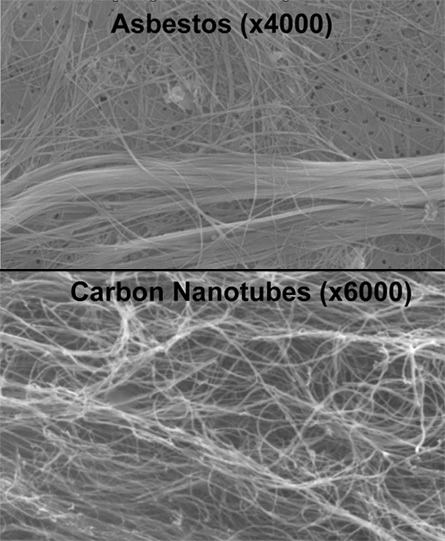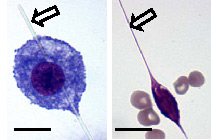As the saying goes, if it looks like a duck and quacks like a duck, it’s reasonable to assume it’s a duck. In light of a new rodent study, environmental scientists worry that the same might apply to asbestos.


Certain long carbon nanotubes — tiny cylinders only 20 micrometers long and perhaps a few micrometers wide — have the same basic dimensions as toxic asbestos fibers. A broad body of data has suggested that the damage caused by asbestos traces more to its physical dimensions than its chemical recipe. So scientists had begun over the past few years expressing concerns that long nanotubes could trigger characteristic asbestos disease, especially mesothelioma — an unusual cancer that is nearly always fatal.
Support for such concerns emerges in the new study, although the study’s duration was too short and its design too simplistic to prove such a link. For instance, asbestos diseases develop slowly over many years, and this study lasted only seven days. Asbestos diseases result from inhalation of toxic mineral fibers, which over time migrate through the wall of the lung to produce disease on the breathing organ’s exterior surface. Here, the researchers released the fibers into the abdomen, giving them direct access to the lung’s exterior mesothelial tissue, where mesothelioma develops.
Despite these caveats, long carbon nanotubes prompted immediate inflammation and a rapid development of lesions in treated mice. Those lesions, symptomatic of the body’s attempt to wall off persistent, irritating materials, are an early — if nonspecific — symptom of asbestos toxicity. Administering long asbestos fibers to mice caused these same responses. Injecting short asbestos fibers or short or tangled carbon nanotubes did not trigger these effects.
Toxicologists led by Craig A. Poland and his colleagues at the University of Edinburgh reported their findings at a news conference May 20. Their data also have been posted in an online paper to appear soon in Nature Nanotechnology.
This study “is a long way” from showing that carbon nanotubes can cause diseases characteristic of asbestos, such as mesothelioma, says André E. Nel, director of the division of nanomedicine at the University of California, Los Angeles. Still, he adds, it demonstrates that carbon nanotubes “do have pathogenic potential.” What’s more, the idea that they might be inhaled “needs to be entertained,” he says, and where these long carbon nanotubes are used, “proper precautions” should be taken to ensure inhalation will be minimized.
The new data also show that all carbon nanotubes are not alike in terms of toxicity. Some were soft, like cooked spaghetti, and the body’s trash-collecting macrophage cells easily scarfed them up. Even short, straight fibers were collected for discarding by these cells. Not so with long multi-walled nanotubes, essentially nested tubes that in cross section display the appearance of tree rings. These especially stiff nanocylinders “frustrated” the macrophages attempts to cull them, says study coauthor Andrew Maynard of the WoodrowWilsonInternationalCenter for Scholars in Washington, D.C.
When a nanotube exceeds 15 micrometers in length, “the macrophage can’t physically stretch itself to engulf the entire fiber,” he says, so the nanotube “ends up penetrating through the edge of the macrophage, killing it.” The macrophage’s demise triggers inflammation and the recruitment of backups that ultimately suffer the same fate. “It’s the same process that happens with asbestos fibers,” he notes.
The study offers strong confirmation for the idea that size and shape are a, if not the, primary factor determining a rigid fiber’s toxicity, Maynard says. The findings also “really shift us from a position of assuming these materials are safe to one where we must assume they’re harmful until we’ve developed information showing they’re not.”






